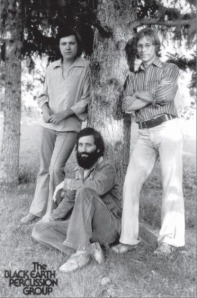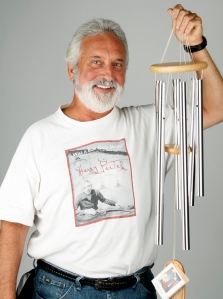I’ve always been interested in the creation of new things. My contribution however has mostly been in the improvement of existing things. I did not invent the windchime but I certainly made some meaningful improvements. Similar items have been around for literally thousands of years. We all know ancient civilizations have used windbells of various types for various purposes. I had been aware of the popularity of windchimes here in the US for a long time, and after studying woodworking, metallurgy and physics for my masters degree I began my lifelong dream of building musical instruments. At that time, the chimes that were commercially available emphasized the visual and not the aural to say the least.
The very first Woodstock Chime (I hadn’t actually called it that then) was built in the wee hours of the night in the basement of our apartment in Cincinnati, Ohio where I was on the faculty of the University of Cincinnati College-Conservatory music at the tender age of 28. My group, the Blackearth Percussion Group was in residence at the conservatory (one of the members, Stacey Bowers, is the Executive VP of Woodstock Chimes today). I had a fascination with the music of ancient civilizations but actual musical examples were non-existent. However the scales were available to a degree. I had access to many of the scales of these ancient civilizations prior to the Internet as a result of library research I had done while working on my master’s. One of my resources was a book by composer Harry Partch entitled Genesis of a Music. In this book, Harry Partch gave the ratios
of a scale (from which the “notes” could be recreated) used by Olympos, a seventh century BC Greek composer and flute player. The system of tuning back then was quite different than what we have today so in order to hear the real sound of this intriguing scale, one had to build an instrument. The modern day piano isn’t capable of reproducing the exact intervals. One of the easiest ways of recreating the scale for me was to tune a set aluminum tubes since the only factor in determining the notes was the length of the tubes and I knew the formulas for length and frequency from my study of physics. So I tuned this scale (the first experiments used the repurposed tubes from discarded lawn chairs) and played the tubes like one might play a xylophone. At some point I decided I needed to share this amazing discovery with others, especially those who didn’t want to learn to play the xylophone! But how to do that? Somehow the idea of configuring these tubes into a set of windchimes came to me. Late one night in 1979 I stayed up and made the very first Woodstock windchime tuned to the scale of Olympos. I used everything I learned in College to not only tune it correctly but to make sure the laws of musical acoustics were taken into consideration. Where the tube was struck, where the tube was suspended, what kind of wood was used to strike the tube were a few of the factors.
The next morning I showed this to my wife Diane who actually thought it was beautiful. As a result she let me show it in her booth at an art fair on the river in Cincinnati that spring which contained her artwork comprised of mostly soft sculpture clothing, purses and wall hangings. I built three chimes all together, hung them in her booth and to our surprise, the windchimes sold immediately. A few weeks later, we decided we wanted to live in a more natural environment which Cincinnati (or any city) didn’t offer. We looked throughout the northeast of the US that spring, finally finding the Hudson Valley and more specifically the area surrounding the artist colony of Woodstock New York and the Catskill Mountains. We continued showing the chimes at craft shows for a few years until we decided to step it up and find retail outlets to market the chimes. I still love the sound of the Chimes of Olympos, a hauntingly melancholy ancient sound. When I listen to it, I often think I am hearing a voice from the very distant past and the melodies that this mysterious musician may have actually played.



